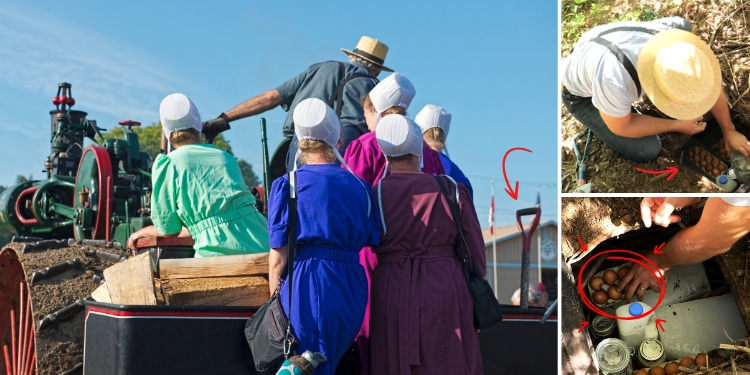The Amish have quietly preserved a way of life that values simplicity and self-reliance, offering a time-tested blueprint for not just surviving, but thriving, off the grid. One of their most practical and deeply rooted traditions is burying food—a method steeped in ancient wisdom and still crucial for their survival today. For the Amish, this isn’t just a quaint relic of the past; it’s a critical survival technique that modern preppers can and should learn from.
The Core Wisdom: Why This Tradition Endures
The Amish practice of burying food is a survival strategy that helps them live without relying on fragile modern systems. It’s a powerful lesson in resourcefulness and self-reliance that every prepper should understand.
- Natural, Off-Grid Refrigeration: Most Amish communities live without electricity. This means no refrigerators, freezers, or electric dehydrators. Their solution is the earth itself. A few feet below the surface, temperatures remain a consistent 45° to 55°F year-round. This creates a natural, free refrigerator that is perfect for storing a surprising variety of foods.
- The Ultimate Frugality: Why spend money on ice, fuel, or a modern appliance when the ground offers a reliable and free storage solution? This low-tech approach aligns perfectly with their values of wasting nothing, living humbly, and relying on the land as their primary provider.
- A Safe, Resilient Food Reserve: A house or barn can burn down. A tornado can strike. But a stash of food stored deep in the ground is usually safe from these surface-level disasters. This provides a critical backup supply, giving the community the nourishment they need to rebuild after a crisis.
- Passing Down a Legacy: This practice is more than just a chore; it’s a tradition. It’s grandparents teaching grandchildren how to build a root cellar, how to can properly, and how to use clay or sand for insulation. It’s a way of life that ensures essential survival skills are passed down through the generations, preserving a legacy of self-sufficiency.
What Foods Can You Bury? A Surprising Variety
You might be surprised by the variety of foods the Amish can safely store underground. Over centuries, they’ve fine-tuned these methods to preserve a wide range of surplus food items.
- Root Vegetables: Potatoes, carrots, beets, turnips, and parsnips are ideal candidates for buried storage. They’re typically layered in bins or barrels, with a modest layer of sand or sawdust scattered between each to maintain moisture balance and prevent rot.
- Canned and Jarred Goods: The Amish often store home-canned vegetables, fruits, meats, and pickled items underground. The stable temperature and darkness of an underground pit or cellar extend their shelf life. When dug deep enough, buried jars can remain viable for years.
- Alliums: Garlic, onions, and leeks are often braided and hung in underground spaces, where they are protected from freezing and held at the proper moisture level. Hanging them from the ceiling also keeps them safe from rodents and other pests.
- Fermented Foods: In colder climates, some families bury crocks of fermented foods like sauerkraut. Once the fermentation is complete, the high salinity and beneficial bacteria of the fermented food keep it safe in cool, underground conditions for up to a year.
- Dairy and More: In some of the coldest northern climates, the Amish wrap butter in waxed cloth and store it in earthen pits lined with straw. This keeps it cold and edible throughout the winter without taking up space in the kitchen.
How to Replicate This Method: Tools and Techniques
If you want to replicate these time-tested food storage methods, you don’t need high-tech gear. All you really need is deep soil, time, and a little know-how.
- The Root Cellar: This is the gold standard for Amish food storage. It’s a small underground room, often built into a hillside or dug several feet below ground. The walls are reinforced with stone or heavy timbers, and an earthen floor helps regulate humidity. A simple vent system prevents mold and controls condensation.
- In-Ground Pits and Mini-Cellars: If you don’t have space for a full cellar, a barrel or a large, heavy-duty trash can can be buried in the ground to serve as a “mini-cellar” for a smaller food stash. Ideally, you want at least two to three feet of soil above the lid to maximize the insulating properties of the earth.
- Simple Materials: You can make a sturdy in-ground food storage locker with just a shovel, some heavy-duty totes, and scrap lumber. A layer of clay on top of your buried container can even provide a bit of natural waterproofing.
Final Thoughts: The Wisdom of the Ground
The Amish don’t bury their food out of nostalgia. They do it because it works. Their methods have stood the test of time, winter, and economic hardship. Keeping a buried stash of food or other supplies is a wise move in any preparedness strategy, giving you a crucial backup if your primary supplies are compromised. Whether you decide to build a full-blown root cellar or start small with a buried bin of potatoes, you’re tapping into a tradition that is both practical and safe.




